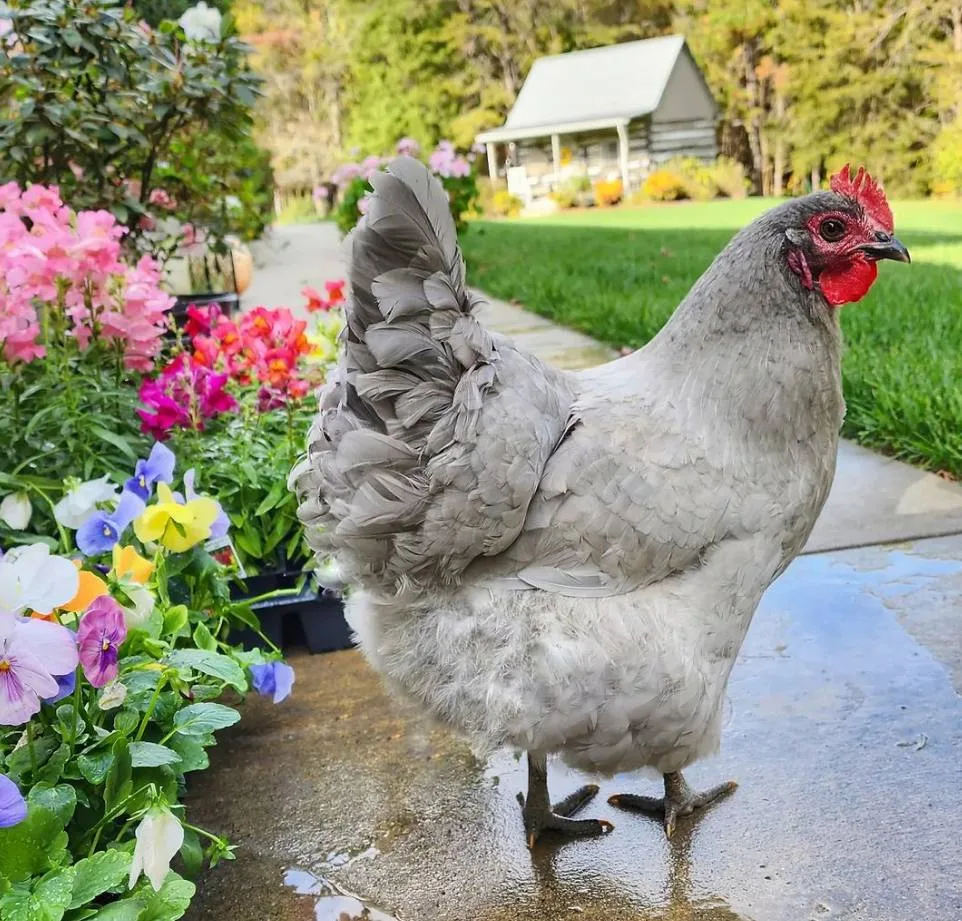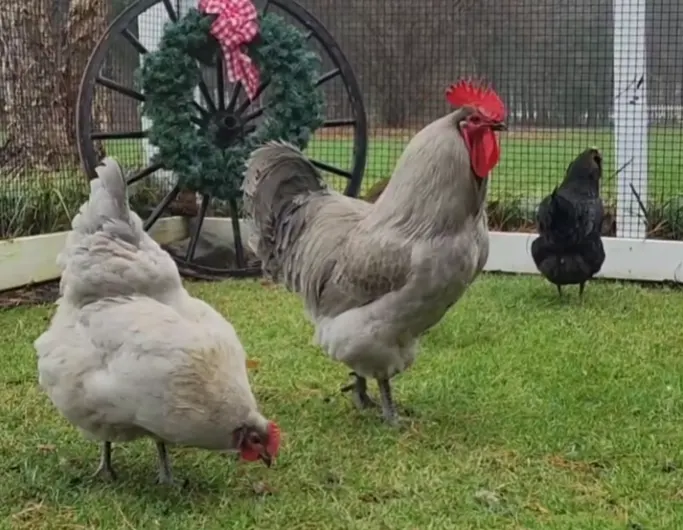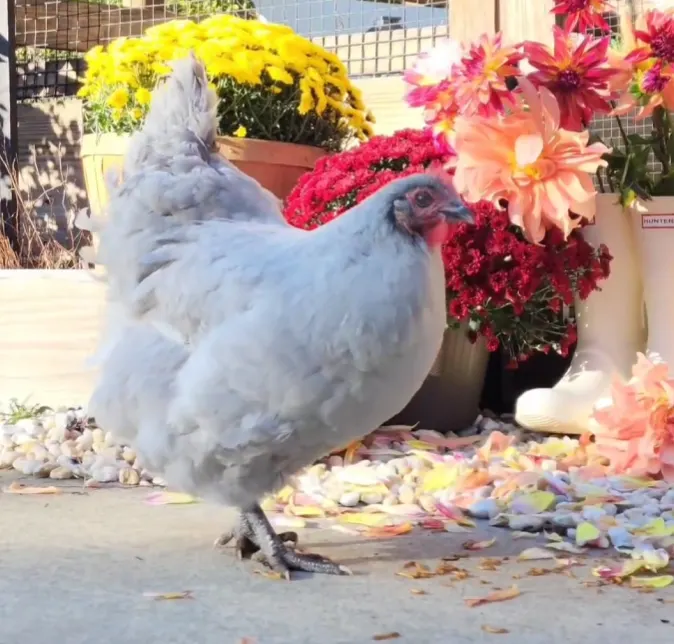Lavender Orpington chickens are a popular breed of chicken known for their stunning appearance and friendly temperament.
They are a great addition to any homestead flock, as they are easy to care for and lay plenty of eggs each year.
These chickens are also cold-hardy, making them a great choice for those living in colder climates.
Lavender Orpingtons are also docile and friendly, making them great pets for families with children.
In this article, we will discuss:
- Lavender Orpington overview, history, and origin
- Their appearance and temperament
- Health, lifespan, and egg production of these birds
- How to care for Lavender Orpington chickens
- Some frequently asked questions

Lavender Orpington Overview
| Lifespan | 8-10 years |
| Weight | Hens: 6-8 lbs, Roosters: 10 lbs |
| Appearance | Soft gray-blue and lavender plumage |
| Egg Color | Light Brown |
| Egg Size | Medium to Large |
| Egg Production | 170-200 per year (3-4 per week) |
| Broodiness Level | Medium to High |
| Beginner Friendly | Yes |
| Space Needed | 4 square feet per bird inside the coop, 8-10 square feet outdoors |
| Price | $4-$10 per chick |
History and Origin
The Lavender Orpington, also known as the Self-Blue Orpington, is a relatively new breed of chicken that originated in England in the early 20th century.
The Orpington breed, from which the Lavender Orpington was developed, was created by William Cook in 1886 in the village of Orpington, Kent.
Cook’s vision was to create a hardy and soft-feathered dual-purpose bird that was a substantial meat producer and productive egg layer.
Prior to this, English chicken breeds were fairly “scrawny” and not considered to be good meat birds.
The Lavender Orpington was first introduced in the late 1990s by Priscilla Middleton in England and John W. Blehm in America.
They bred black Orpingtons with lavender genes from other breeds, such as Araucanas and Dorkings, to create the first Lavender Orpington.
Following that, many breeders worked to refine the breed and establish its distinguishing features.
The Lavender Orpington has become increasingly popular in recent years due to its unique lavender color and friendly personality.
They are known to be docile and calm, making them a great choice for backyard flocks.
The Lavender Orpington is also a dual-purpose breed, meaning they are good for both meat and egg production.

Physical Characteristics
The Lavender Orpington is a beautiful breed that has become increasingly popular in recent years.
They have a unique lavender color and are known for their large size and fluffy feathers.
In this section, we will discuss the size, weight, and overall appearance of these beautiful birds.
Size and Weight
Lavender Orpingtons are a large breed of chicken, with roosters weighing between 8-10 pounds and hens weighing between 6-8 pounds.
They have an upright stance and a broad, deep body.
Despite their size, they are known for their gentle and docile nature.
Appearance
Lavender Orpingtons have a fluffy and soft appearance due to their abundant feathering.
They have a medium-sized, 5-pointed single comb and red earlobes, wattles, and comb.
Their feet and shanks are slate or blue in color and generally free of feathers, although a few feathers may be seen on the shanks of non-show birds.
Color
The Lavender Orpington’s color is a light gray-blue with violet-lavender shimmering hues in the sunlight.
In person, these birds are strikingly beautiful, but capturing their unique beauty on camera can be difficult.
They have a pearl-like silvery-lilac tint that gives them a distinct appearance.
Their feathers are soft and fluffy, which makes them a popular breed for both showing and keeping as pets.
Overall, the Lavender Orpington is a beautiful and gentle breed of chicken with a unique color and appearance.

Breed Standard
The Lavender Orpington chicken is not officially recognized as a color variety in the United States or the UK.
However, Orpingtons are a popular breed and it is possible for the lavender variety to become a standard breed in the future.
According to the American Poultry Association (APA), general Orpington breed standards state that they should be broad-bodied and low to the ground.
They should also a short and curvy back with shorter tail feathers.
Temperament and Behavior
Lavender Orpingtons are known for their calm, friendly, and docile temperament.
They are gentle birds that are easy to handle, making them a great choice for families with children.
These birds are not aggressive and rarely make noise, making them a quiet addition to any flock.
Due to their docile temperament, Lavender Orpingtons are often considered lap chickens.
They enjoy being held and petted, and will often follow their owners around the yard.
Lavender Orpingtons are also known to be good with other chickens and are happiest in large flocks.
They are not territorial and will often share food and water with other birds.
However, roosters can be territorial, especially if there is only one in the flock.
Aggressive roosters can be socialized to help mellow out their temperament.
Health and Lifespan
Lavender Orpingtons are generally robust chickens that can live for 8-10 years with proper care and nutrition.
They are also relatively resistant to diseases and parasites, which means that they require minimal medical attention.
While they are hardy birds that can handle the cold pretty well, there are some health concerns to watch out for.
One of the common health issues that Lavender Orpingtons may face is obesity.
These chickens have a tendency to overeat, which can lead to health problems such as heart disease and joint issues.
To prevent obesity, it is important to monitor their food intake and provide them with a balanced diet.
Another important factor to consider for the health of Lavender Orpingtons is temperature.
While they can handle the cold, extreme temperatures can be harmful to their health.
It is important to provide them with a warm and dry shelter during the winter months to prevent frostbite and other cold-related health issues.
Breeding and Genetics
Breeding Lavender Orpingtons can be a bit tricky due to the recessive nature of the Lavender gene.
Only Orpingtons with two copies of the gene will have the Lavender color, while those with one copy are normal-colored and called Split Lavender Orpingtons.
Pure Lavender Orpingtons breed true, so the offspring will always be 100% Lavender.
When breeding Lavender Orpingtons, it is important to keep track of the genetics of the flock.
If two Lavender Orpingtons are bred together, all of their offspring will be Lavender.
However, if a Lavender Orpington is bred with a normal-colored Orpington, only half of the offspring will be Split Lavender Orpingtons, and the other half will be normal-colored.
It is also important to note that Lavender Orpingtons can be prone to broodiness, which can affect their egg-laying capabilities.
If a Lavender Orpington goes broody, they may stop laying eggs altogether. However, they can also be great mothers and will happily raise their own chicks.
When purchasing Lavender Orpington chicks or hatching eggs, it is important to ensure that they come from reputable breeders who are knowledgeable about the genetics of the breed.
It is also important to note that while Lavender Orpingtons are a rare and sought-after breed, they should not be excessively priced compared to other Orpington varieties.
If a breeder is asking more than $10 for a small chick, it is best to look elsewhere.
Lavender Orpington Egg Production
The Lavender Orpington is a good layer, producing around 170-200 eggs per year, which is a decent amount for a backyard chicken.
Their eggs are medium-sized and light brown in color.
It is important to note that the number of eggs a chicken lays can vary depending on several factors such as age, diet, and environment.
Providing a balanced diet, clean water, and a comfortable living space can help ensure optimal egg production.
Broodiness
Lavender Orpingtons are also known for their broodiness, which means they have a tendency to want to sit on their eggs and hatch them.
This can be a positive trait if you are interested in hatching your own chicks, but it can also result in a decrease in egg production.
Caring for Lavender Orpingtons
Lavender Orpingtons are a beautiful and gentle breed of chicken that requires proper care to thrive.
In this section, we will discuss the essential aspects of caring for Lavender Orpingtons, including their diet, housing, and protection.
Diet
Lavender Orpington chicks should be started on a starter feed that consists of at least 20% protein for the first 14-16 weeks.
Then it is recommended to switch them to a high-end commercial layer feed that contains at least 16% protein.
You can supplement their diet with fruits, vegetables, and mealworms.
Make sure to provide clean water at all times.
Free Ranging
Lavender Orpingtons are foragers and enjoy free-ranging in the backyard.
They will eat a variety of foods, including insects, seeds, and greens.
However, they also need a balanced diet to stay healthy and lay eggs regularly.
Housing
Lavender Orpingtons are a medium-sized breed and require adequate space to roam and exercise.
A chicken coop with a minimum of 4 square feet per bird is recommended, with an additional 10 square feet of outdoor space per bird.
The coop should be well-ventilated, dry, and clean.
Provide nesting boxes filled with clean nesting material, such as straw or wood shavings.
Lavender Orpingtons are docile and friendly, so it’s essential to provide enough roosting space to avoid any issues with the pecking order.
Protection
Lavender Orpingtons are susceptible to predators, such as raccoons, foxes, and hawks.
It’s crucial to provide adequate protection to keep them safe.
Make sure the chicken coop is secure and has no holes or gaps that predators can enter through.
You can also use electric fencing or netting to keep predators out of the outdoor space.
It’s also advisable to supervise the chickens when they are free-ranging in the backyard.
Temperature
One benefit of owning Lavender Orpingtons is that they do well in both cold and warmer environments.
However, because of their dense feathers, they do better in colder climates.
If they are introduced to snow, it is extremely important to keep their feathers dry so that they do not get frostbite.
In the warmer months, it is best to provide them with adequate shade, dust baths, and cool water to keep them comfortable.
You can also provide them with cold treats such as watermelon or cucumber.

Popularity and Pricing
Lavender Orpingtons have become increasingly popular in recent years, especially among backyard chicken keepers and homesteaders.
Additionally, their beautiful lavender plumage makes them a favorite among chicken enthusiasts who are looking for a unique and eye-catching addition to their flock.
When it comes to pricing, Lavender Orpingtons are generally more expensive than other breeds of chickens.
The cost of a Lavender Orpington chick can range anywhere from $4 to $8, depending on the sex of the bird.
However, the price of a mature Lavender Orpington chicken can be much higher, with some breeders asking upwards of $50 per mature hen.
Despite their higher price point, many chicken keepers believe that Lavender Orpingtons are well worth the investment.
Not only are they beautiful and friendly birds, but they also lay large brown eggs and are known for their excellent meat quality.
Additionally, their dual-purpose nature makes them a practical choice for those who are looking to raise chickens for both eggs and meat.
It’s important to note that while Lavender Orpingtons are sometimes referred to as “designer chickens,” they are still a legitimate breed of chicken with their own unique characteristics and traits.
While they may be more expensive than other breeds, their popularity and practicality make them a worthwhile investment for many chicken enthusiasts.
Comparison with Other Breeds
Lavender Orpingtons are a popular breed of chicken that are known for their gentle nature and beautiful plumage.
But how do they compare to other popular chicken breeds?
When it comes to size, Lavender Orpingtons are similar to Buff Orpingtons and Black Orpingtons.
All three breeds are large and heavy, with broad backs and fluffy feathers.
Cochins are also a large breed, but they tend to have shorter, more rounded bodies.
In terms of temperament, Lavender Orpingtons are known for being friendly and docile, much like the Buff Orpington.
Black Orpingtons can be a bit more aloof, while Cochins and Dorkings are known for being calm and gentle.
When it comes to egg production, Lavender Orpingtons are moderate layers, with the potential to lay up to 200 eggs per year.
This is similar to the Dorking breed, but less than the Spangled Hamburgs, which can lay up to 280 eggs per year.
One thing that sets Lavender Orpingtons apart from other breeds is their unique coloration.
While Buff and Black Orpingtons are more common, the lavender color is rare and highly sought after by chicken enthusiasts.
Final Thoughts
Lavender Orpington chickens are strikingly beautiful with docile and friendly personalities and decent egg-laying abilities.
These birds are larger than some others and they are used for both eggs and meat.
They are also hardy and fairly easy to care for.
Lavender Orpingtons are friendly, docile, and fun to have around, making them a great choice for families with children and other pets.
But while these birds may seem like the whole package, it is important to do your research to ensure that they are right for your environment and preferences.
What do you think? Is the Lavender Orpington the best choice for you and your flock?
Frequently Asked Questions
What color eggs do Lavender Orpingtons lay?
Lavender Orpingtons lay light brown eggs, similar to other Orpington breeds.
The color of the egg may vary slightly depending on the individual bird, but they generally produce eggs with a consistent color.
What is the difference between Lavender and Buff Orpingtons?
The main difference between Lavender and Buff Orpingtons is their color.
Lavender Orpingtons have a pale lavender or violet color, while Buff Orpingtons have a golden buff color.
Additionally, Lavender Orpingtons are a relatively new color variety, while Buff Orpingtons have been around for over a century.
Why are Lavender Orpingtons so expensive?
Lavender Orpingtons are relatively rare and in high demand, which can drive up their price.
Additionally, breeding Lavender Orpingtons can be more challenging than breeding other color varieties, which can also contribute to their higher price.
Are Lavender Orpingtons good egg layers?
Yes, Lavender Orpingtons are good egg layers, with an average of 170-200 eggs per year, or 3-4 per week.
They are also known for producing larger-than-average eggs.
What is the temperament of Lavender Orpingtons?
Lavender Orpingtons are known for their friendly and docile temperament, making them a great choice for backyard flocks.
They are also good with children and can be easily handled.
When do Lavender Orpingtons start laying?
Lavender Orpingtons typically start laying eggs at around 5-6 months of age, although this can vary depending on the individual bird and environmental factors.
Chicken Breed Guides

